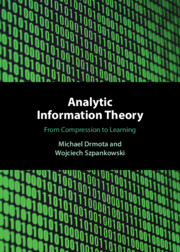Refine listing
Actions for selected content:
9096 results in Communications, Signal Processing and Information Theory
Appendix A - Useful Formulas
-
- Book:
- Quantum Theory
- Published online:
- 06 October 2023
- Print publication:
- 31 August 2023, pp 619-621
-
- Chapter
- Export citation
1 - The Classical World
- from Part I - Introduction
-
- Book:
- Quantum Theory
- Published online:
- 06 October 2023
- Print publication:
- 31 August 2023, pp 3-23
-
- Chapter
- Export citation
13 - Particles in Three Dimensions
- from Part III - Elementary Systems and Their Symmetries
-
- Book:
- Quantum Theory
- Published online:
- 06 October 2023
- Print publication:
- 31 August 2023, pp 333-363
-
- Chapter
- Export citation
16 - Relativistic Systems
- from Part III - Elementary Systems and Their Symmetries
-
- Book:
- Quantum Theory
- Published online:
- 06 October 2023
- Print publication:
- 31 August 2023, pp 412-438
-
- Chapter
- Export citation
12 - Symmetries II
- from Part III - Elementary Systems and Their Symmetries
-
- Book:
- Quantum Theory
- Published online:
- 06 October 2023
- Print publication:
- 31 August 2023, pp 305-332
-
- Chapter
- Export citation
Part V - Quantum Foundations
-
- Book:
- Quantum Theory
- Published online:
- 06 October 2023
- Print publication:
- 31 August 2023, pp 567-618
-
- Chapter
- Export citation
Reviews
-
- Book:
- Quantum Theory
- Published online:
- 06 October 2023
- Print publication:
- 31 August 2023, pp ii-ii
-
- Chapter
- Export citation
15 - Particle Statistics and Field–Particle Duality
- from Part III - Elementary Systems and Their Symmetries
-
- Book:
- Quantum Theory
- Published online:
- 06 October 2023
- Print publication:
- 31 August 2023, pp 383-411
-
- Chapter
- Export citation
14 - Particles with Spin
- from Part III - Elementary Systems and Their Symmetries
-
- Book:
- Quantum Theory
- Published online:
- 06 October 2023
- Print publication:
- 31 August 2023, pp 364-382
-
- Chapter
- Export citation
Part I - Introduction
-
- Book:
- Quantum Theory
- Published online:
- 06 October 2023
- Print publication:
- 31 August 2023, pp 1-52
-
- Chapter
- Export citation
Contents
-
- Book:
- Quantum Theory
- Published online:
- 06 October 2023
- Print publication:
- 31 August 2023, pp vii-xiv
-
- Chapter
- Export citation
2 - The Birth of Quantum Theory
- from Part I - Introduction
-
- Book:
- Quantum Theory
- Published online:
- 06 October 2023
- Print publication:
- 31 August 2023, pp 24-52
-
- Chapter
- Export citation
20 - Open Quantum Systems
- from Part IV - Techniques
-
- Book:
- Quantum Theory
- Published online:
- 06 October 2023
- Print publication:
- 31 August 2023, pp 537-566
-
- Chapter
- Export citation
6 - Quantum Probabilities
- from Part II - The Principles of Quantum Theory
-
- Book:
- Quantum Theory
- Published online:
- 06 October 2023
- Print publication:
- 31 August 2023, pp 139-168
-
- Chapter
- Export citation
Part IV - Techniques
-
- Book:
- Quantum Theory
- Published online:
- 06 October 2023
- Print publication:
- 31 August 2023, pp 439-566
-
- Chapter
- Export citation
10 - Quantum–Classical Correspondence
- from Part II - The Principles of Quantum Theory
-
- Book:
- Quantum Theory
- Published online:
- 06 October 2023
- Print publication:
- 31 August 2023, pp 248-270
-
- Chapter
- Export citation
Index
-
- Book:
- Quantum Theory
- Published online:
- 06 October 2023
- Print publication:
- 31 August 2023, pp 659-662
-
- Chapter
- Export citation

Analytic Information Theory
- From Compression to Learning
-
- Published online:
- 24 August 2023
- Print publication:
- 07 September 2023
11 - Integer Coding
-
- Book:
- Pearls of Algorithm Engineering
- Published online:
- 08 June 2023
- Print publication:
- 22 June 2023, pp 194-209
-
- Chapter
- Export citation
4 - List Ranking
-
- Book:
- Pearls of Algorithm Engineering
- Published online:
- 08 June 2023
- Print publication:
- 22 June 2023, pp 32-43
-
- Chapter
- Export citation
